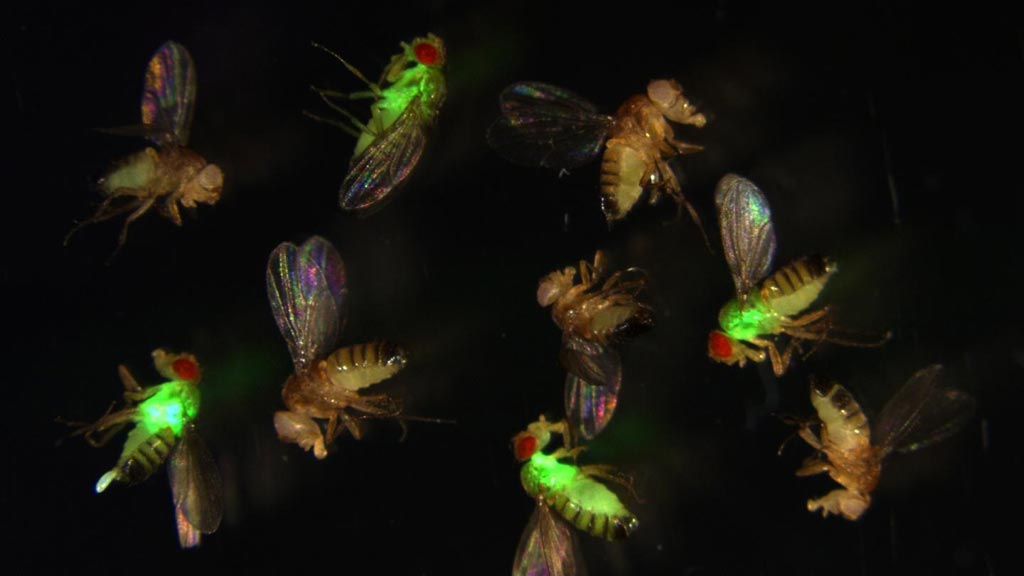Gene Editing Reveals Interaction between Antimicrobial Peptides and Pathogens
By LabMedica International staff writers
Posted on 13 Mar 2019
The genome editing tool CRISPR/Cas9 was used to delete the genes coding for inducible antimicrobial peptides (AMPs) in fruit flies (Drosophila), which revealed the highly specific interaction between AMPs and pathogens in an in vivo model system.Posted on 13 Mar 2019
CRISPR/Cas9 is regarded as the cutting edge of molecular biology technology. CRISPRs (clustered regularly interspaced short palindromic repeats) are segments of prokaryotic DNA containing short repetitions of base sequences. Each repetition is followed by short segments of "spacer DNA" from previous exposures to a bacterial virus or plasmid. Since 2013, the CRISPR/Cas9 system has been used in research for gene editing (adding, disrupting, or changing the sequence of specific genes) and gene regulation. By delivering the Cas9 enzyme and appropriate guide RNAs (sgRNAs) into a cell, the organism's genome can be cut at any desired location. The conventional CRISPR/Cas9 system from Streptococcus pyogenes is composed of two parts: the Cas9 enzyme, which cleaves the DNA molecule and specific RNA guides that shepherd the Cas9 protein to the target gene on a DNA strand.

Image: Fruit flies (Drosophila) with mutated antimicrobial peptides (red eyes) let bacteria (green fluorescence) grow out of control, while wild-type flies (with normal antimicrobial peptides) suppress the infection (Photo courtesy of Dr. Mark Austin Hanson, École Polytechnique Fédérale de Lausanne).
Antimicrobial peptides are a unique and diverse group of molecules, which are divided into subgroups on the basis of their amino acid composition and structure. Antimicrobial peptides are generally composed of between 12 and 50 amino acids. These peptides include two or more positively charged residues provided by arginine, lysine or, in acidic environments, histidine, and a large proportion (generally more than 50%) of hydrophobic residues. AMPs can possess multiple activities including anti-gram-positive bacterial, anti-gram-negative bacterial, anti-fungal, anti-viral, anti-parasitic, and anti-cancer activities. The amphipathicity of the antimicrobial peptides allows them to partition into the membrane lipid bilayer of the pathogen. The ability to associate with membranes is a definitive feature of antimicrobial peptides, and they have a variety of antimicrobial activities ranging from membrane permeabilization to action on a range of cytoplasmic targets.
Investigators at École Polytechnique Fédérale de Lausanne (Switzerland) utilized CRISPR gene editing to delete all known immune inducible AMPs of Drosophila, namely: four attacins, four cecropins, two diptericins, drosocin, drosomycin, metchnikowin, and defensin. Using individual and multiple knockouts, including flies lacking all 14 AMP genes, they characterized the in vivo function of individual and groups of AMPs against diverse bacterial and fungal pathogens.
Results published in the February 26, 2019, online edition of the journal eLife revealed that Drosophila AMPs acted primarily against Gram-negative bacteria and fungi, contributing either additively or synergistically. In addition, the investigators found that certain AMPs could be incredibly specific in defending against certain infections (e.g., the AMP diptericin against the pathogen Providencia rettgeri).
“What is really exciting is that these results will help us understand how our own AMPs might help fight infection,” said first author Dr. Mark Austin Hanson, a doctoral assistant at École Polytechnique Fédérale de Lausanne. “It could be that some people have a defective copy of a specific AMP needed to prevent a common infection - as an example, uropathogenic E. coli - and so they are at higher risk. Fighting infection is great, but learning how to prevent it in the first place is the ideal of medicine. That is what these AMPs do: they prevent infection before it ever settles in.”
Furthermore, said Dr. Hanson, “Studying how the fly’s AMPs work can also help us manage economically important insects, whether it be protecting bumblebees or preventing mosquitoes from spreading disease.”
Related Links:
École Polytechnique Fédérale de Lausanne







 assay.jpg)






